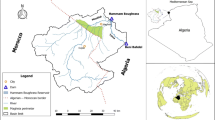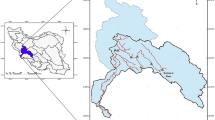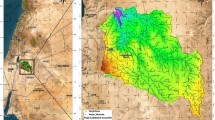Abstract
Real-world problems often contain complex structures and various variables, and classical optimization techniques may face difficulties finding optimal solutions. Hence, it is essential to develop efficient and robust techniques to solve these problems. Computational intelligence (CI) optimization methods, such as swarm intelligence (SI) and evolutionary computation (EC), are promising alternatives to conventional gradient-based optimizations. SI algorithms are multi-agent systems inspired by the collective behavior of individuals, while EC algorithms implement adaptive search inspired by the evolution process. This study aims to compare SI and EC algorithms and to compare nature-based and human-based algorithms in the context of water resources planning and management to optimize reservoir operation. In this study four optimization algorithms, including particle swarm optimization (PSO), teaching–learning based optimization algorithm (TLBO), genetic algorithm (GA), and cultural algorithm (CA), were applied to determine the optimal operation of the Aydoghmoush reservoir in Iran. This study used four criteria, known as objective function value, run time, robustness, and convergence rate, to compare the overall performances of the selected optimization algorithms. In term of the objective function, PSO, TLBO, GA, and CA achieved 2.81 × 10–31, 1.66 × 10–24, 4.29 × 10–4, and 1.44 × 10–2, respectively. The results suggested that although both SI and EC algorithms performed acceptably and provided optimal solutions for reservoir operation, SI algorithms outperformed the EC algorithms in terms of accuracy of solutions, convergence rate, and run time to reach global optima.




Similar content being viewed by others
Availability of Data and Material
The data that support the findings of this study are available from the corresponding author upon reasonable request.
Code Availability
The codes that support the findings of this study are available from the corresponding author upon reasonable request.
References
Ajudiya B, Yadav SM, Majumdar PK (2021) Optimization of cropping patterns in the command area of multiple reservoir system using TLBO algorithm. ISH J Hydraul Eng 1–10. https://doi.org/10.1080/09715010.2021.1885507
Akbari-Alashti H, Haddad OB, Fallah-Mehdipour E, Mariño MA (2014) Multi-reservoir real-time operation rules: a new genetic programming approach. Proc Inst Civ Eng Water Manage 167(10):561–576. https://doi.org/10.1680/wama.13.00021
Ashofteh PS, Bozorg-Haddad O, Loáiciga HA (2020) Logical genetic programming (LGP) application to water resources management. Environ Monit Assess 192(1). https://doi.org/10.1007/s10661-019-8014-y
Atashpaz-Gargari E, Lucas C (2007) Imperialist competitive algorithm: an algorithm for optimization inspired by imperialistic competition. 2007 IEEE Congress on Evolutionary Computation CEC 2007 4661–4667. https://doi.org/10.1109/CEC.2007.4425083
Bansal JC (2019) Particle swarm optimization. In: Bansal JC, Singh PK, Pal NR (Eds.), Evolutionary and Swarm Intelligence Algorithms (pp. 11–23). Springer International Publishing. https://doi.org/10.1007/978-3-319-91341-4_2
Bansal JC, Pal NR (2019) Swarm and evolutionary computation. In: Bansal JC, Singh PK, Pal NR (Eds.), Evolutionary and Swarm Intelligence Algorithms (pp. 1–9). Springer International Publishing. https://doi.org/10.1007/978-3-319-91341-4_1
Banzhaf W, Francone FD, Keller RE, Nordin P (1998) Genetic programming: an introduction: on the automatic evolution of computer programs and its applications. Morgan Kaufmann Publishers Inc
Basturk B, Karaboga D (2006) An artificial bee colony (ABC) algorithm for numeric function optimization. Proc IEEE Swarm Intell Symp 2006:12–14
Beyer HG, Schwefel HP (2002) Evolution strategies – a comprehensive introduction. Nat Comput 1(1):3–52. https://doi.org/10.1023/A:1015059928466
Bordbar M, Neshat A, Javadi S, Pradhan B, Aghamohammadi H (2020) Meta-heuristic algorithms in optimizing GALDIT framework: a comparative study for coastal aquifer vulnerability assessment. J Hydrol 585(August 2019):124768. https://doi.org/10.1016/j.jhydrol.2020.124768
Bozorg-Haddad O, Afshar A, Mariño MA (2006) Honey-bees mating optimization (HBMO) algorithm: a new heuristic approach for water resources optimization. Water Resour Manage 20(5):661–680. https://doi.org/10.1007/s11269-005-9001-3
Bozorg-Haddad O, Azad M, Fallah-Mehdipour E, Delpasand M, Chu X (2021) Verification of FPA and PSO algorithms for rule curve extraction and optimization of single- and multi-reservoir systems’ operations considering their specific purposes. Water Sci Technol: Water Suppl 21(1):166–188. https://doi.org/10.2166/ws.2020.274
Bozorg-Haddad O, Moradi-Jalal M, Mirmomeni M, Kholghi MKH, Mariño MA (2009) Optimal cultivation rules in multi-crop irrigation areas. Irrig Drain 58(1):38–49. https://doi.org/10.1002/ird.381
Bozorg-Haddad O, Zolghadr-Asli B, Sarzaeim P, Aboutalebi M, Chu X, Loáiciga HA (2020) Evaluation of water shortage crisis in the Middle East and possible remedies. J Water Suppl: Res Technol - AQUA 69(1):85–98. https://doi.org/10.2166/aqua.2019.049
Cassagnole M, Ramos MH, Zalachori I, Thirel G, Garçon R, Gailhard J, Ouillon T (2021) Impact of the quality of hydrological forecasts on the management and revenue of hydroelectric reservoirs-a conceptual approach. Hydrol Earth Syst Sci 25(2):1033–1052. https://doi.org/10.5194/hess-25-1033-2021
Chakraborty A, Kar AK (2017) Swarm intelligence: a review of algorithms. In: Patnaik S, Yang X-S, Nakamatsu K (Eds.), Nature-Inspired Computing and Optimization: Theory and Applications (pp. 475–494). Springer International Publishing. https://doi.org/10.1007/978-3-319-50920-4_19
Chu SC, Tsai PW (2007) Computational intelligence based on the behavior of cats. Int J Innov Comput Info Control 3(1):163–173
Chen J, Yu C, Cai M, Wang H, Zhou P (2020) Multi-objective optimal allocation of urban water resources while considering conflict resolution based on the PSO algorithm: a case study of Kunming, China. Sustainability (Switzerland) 12(4). https://doi.org/10.3390/su12041337
Chen N, Liu W, Bai R, Chen A (2019) Application of computational intelligence technologies in emergency management: a literature review. Artif Intell Rev 52(3):2131–2168. https://doi.org/10.1007/s10462-017-9589-8
Cheng S, Ma L, Lu H, Lei X, Shi Y (2021) Evolutionary computation for solving search-based data analytics problems. Artif Intell Rev 54(2):1321–1348. https://doi.org/10.1007/s10462-020-09882-x
Dogan MS, Lund JR, Medellin-Azuara J (2021) Hybrid linear and nonlinear programming model for hydropower reservoir optimization. J Water Resour Plan Manag 147(3):06021001. https://doi.org/10.1061/(ASCE)WR.1943-5452.0001353
Dorigo M, Birattari M, Stutzle T (2006) Ant colony optimisation. IEEE Comput Intell Mag 1:28–39
Eiben AE, Smith JE (2015) Introduction to evolutionary computing. In: Natural Computing Series (vol. 28). Springer Berlin Heidelberg. https://doi.org/10.1007/978-3-662-44874-8
Engelbrecht AP (2007) Computational intelligence: an Introduction. Wiley. ISBN: 978-0-470-51250-0
Fogel LJ, Owens AJ, Walsh MJ (1967) Artificial intelligence through simulated evolution. Wiley Hoboken.
Holland JH (1992) Genetic algorithms. Sci Am 267(1):66–72. https://doi.org/10.1038/scientificamerican0792-66
Jahandideh-Tehrani M, Bozorg-Haddad O, Loáiciga HA (2019) Application of non-animal–inspired evolutionary algorithms to reservoir operation: an overview. Environ Monit Assess 191(7). https://link.springer.com/article/10.1007/s10661-019-7581-2
Jahandideh-Tehrani M, Bozorg-Haddad O, Loáiciga HA (2020) A review of applications of animal-inspired evolutionary algorithms in reservoir operation modelling. Water Environ J 0–1. https://doi.org/10.1111/wej.12657
Jamshidpey A, Shourian M (2021) Crop pattern planning and irrigation water allocation compatible with climate change using a coupled network flow programming-heuristic optimization model. Hydrol Sci J 66(1):90–103. https://doi.org/10.1080/02626667.2020.1844889
Kennedy J (2006) Swarm intelligence. In: Zomaya AY (Ed.), Handbook of Nature-Inspired and Innovation Computing (pp. 187–219). Springer US. https://doi.org/10.1007/0-387-27705-6_6
Kennedy J, Eberhart R (1995) Particle swarm optimization. Proc of ICNN’95 – Int Conf Neural Netwo 4(10):1942–1948. https://doi.org/10.1109/ICNN.1995.488968
Kruse R, Borgelt C, Braune C, Mostaghim S, Steinbrecher M (2016) Computational intelligence: a methodological introduction. Springer London. https://doi.org/10.1007/978-1-4471-7296-3
Liu Y, Qin H, Mo L, Wang Y, Chen D, Pang S, Yin X (2019) Hierarchical flood operation rules optimization using multi-objective cultured evolutionary algorithm based on decomposition. Water Resour Manage 33(1):337–354. https://doi.org/10.1007/s11269-018-2105-3
Ma Y, Zhong PA, Xu B, Zhu F, Xiao Y, Lu Q (2020) Multidimensional parallel dynamic programming algorithm based on spark for large-scale hydropower systems. Water Resour Manage 34(11):3427–3444. https://doi.org/10.1007/s11269-020-02566-9
Mani M, Bozorg-Haddad O, Loáiciga HA (2019) A new framework for the optimal management of urban runoff with low-impact development stormwater control measures considering service-performance reduction. J Hydroinf 21(5):727–744. https://doi.org/10.2166/hydro.2019.126
Mendoza Ramírez R, Arganis Juárez ML, Domínguez Mora R, Padilla Morales LD, Fuentes Mariles ÓA, Mendoza Reséndiz A, Carrizosa Elizondo E, Carmona Paredes RB (2021) Operation policies through dynamic programming and genetic algorithms, for a reservoir with irrigation and water supply uses. Water Resour Manage 35(5):1573–1586. https://doi.org/10.1007/s11269-021-02802-w
Mirjalili S (2019a) Genetic algorithm. In: Evolutionary Algorithms and Neural Networks: Theory and Applications (pp. 43–55). Springer International Publishing. https://doi.org/10.1007/978-3-319-93025-1_4
Mirjalili S (2019b) Particle swarm optimisation. In: Evolutionary Algorithms and Neural Networks: Theory and Applications (pp. 15–31). Springer International Publishing. https://doi.org/10.1007/978-3-319-93025-1_2
Mirjalili S, Lewis A (2016) The whale optimization algorithm. Adv Eng Softw 95:51–67. https://doi.org/10.1016/j.advengsoft.2016.01.008
Mirjalili S, Mirjalili SM, Lewis A (2014) Grey Wolf optimizer. Adv Eng Softw 69:46–61. https://doi.org/10.1016/j.advengsoft.2013.12.007
Nayyar A, Garg S, Gupta D, Khanna A (2018) Evolutionary computation. In: Nayyar A, Le D, Nguyen NG (Eds.), Advances in Swarm Intelligence for Optimizing Problems in Computer Science (pp. 1–26). Chapman and Hall/CRC. https://doi.org/10.1201/9780429445927
Pankaj BS, Naidu MN, Vasan A, Varma MR (2020) Self-adaptive cuckoo search algorithm for optimal design of water distribution systems. Water Resour Manage 34(10):3129–3146. https://doi.org/10.1007/s11269-020-02597-2
Peška L, Tashu TM, Horváth T (2019) Swarm intelligence techniques in recommender systems - a review of recent research. Swarm Evol Comput 48(June 2018):201–219. https://doi.org/10.1016/j.swevo.2019.04.003
Rao RV, Savsani VJ, Vakharia DP (2011) Teaching-learning-based optimization: a novel method for constrained mechanical design optimization problems. CAD Comput Aided Des 43(3):303–315. https://doi.org/10.1016/j.cad.2010.12.015
Rao RV, Savsani VJ, Vakharia DP (2012) Teaching-learning-based optimization: an optimization method for continuous non-linear large scale problems. Inf Sci 183(1):1–15. https://doi.org/10.1016/j.ins.2011.08.006
Reynolds RG (1994) An intoduction to cultural algorithms. Proc Third Ann Conf Evol Prog 131–139
Reynolds RG, Chung C (1997) Knowledge-based self-adaptation in evolutionary programming using cultural algorithms. Proc IEEE Congr Evol Comput 71–76. https://doi.org/10.1109/ICEC.1997.592271
Sarzaeim P, Bozorg-Haddad O, Chu X (2018) Teaching-learning-based optimization (TLBO) algorithm. In: Bozorg-Haddad O (Eds.), Advanced Optimization by Nature-Inspired Algorithms (pp. 51–58). Springer Singapore. https://doi.org/10.1007/978-981-10-5221-7_6
Simon D (2008) Biogeography-based optimization. IEEE Trans Evol Comput 12(6):702–713. https://doi.org/10.1109/TEVC.2008.919004
Slowik A, Kwasnicka H (2020) Evolutionary algorithms and their applications to engineering problems. Neural Comput Appl 32(16):12363–12379. https://doi.org/10.1007/s00521-020-04832-8
Solgi M, Bozorg-Haddad O, Loáiciga HA (2020) A multi-objective optimization model for operation of intermittent water distribution networks. Water Sci Technol: Water Suppl 20(7):2630–2647. https://doi.org/10.2166/ws.2020.159
Storn R, Price K (1997) Differential evolution - a simple and efficient heuristic for global optimization over continuous spaces. J Global Optim 11(4):341–359. https://doi.org/10.1023/A:1008202821328
Sun Y, Zhang L, Gu X (2012) A hybrid co-evolutionary cultural algorithm based on particle swarm optimization for solving global optimization problems. Neurocomputing 98:76–89. https://doi.org/10.1016/j.neucom.2011.08.043
Telikani A, Gandomi AH, Shahbahrami A (2020) A survey of evolutionary computation for association rule mining. Inf Sci 524:318–352. https://doi.org/10.1016/j.ins.2020.02.073
Wolpert DH, Macready WG (1997) No free lunch theorems for optimization. IEEE Trans Evol Comput 1(1):67–82. https://doi.org/10.1109/4235.585893
Yang X-S (2010a) A new metaheuristic bat-inspired algorithm. In: González JR, Pelta DA, Cruz C, Terrazas G, Krasnogor N (Eds.), Nature Inspired Cooperative Strategies for Optimization (NICSO 2010a) (pp. 65–74). Springer Berlin Heidelberg. https://doi.org/10.1007/978-3-642-12538-6_6
Yang X-S, Karamanoglu M (2013) 1 - swarm intelligence and bio-inspired computation: an overview. In Yang X-S, Cui Z, Xiao R, Gandomi AH, Karamanoglu M (Eds.) Swarm Intelligence and Bio-Inspired computation, Theory and Application (pp. 3–23). https://doi.org/10.1016/B978-0-12-405163-8.00001-6
Yang XS (2010b) Firefly algorithm, stochastic test functions and design optimization. Int J Bio-Inspired Comput 2(2):78–84. https://doi.org/10.1504/IJBIC.2010.032124
Yang X, Deb S (2009) Cuckoo search via Lévy flights. World Congr Nat Biol Insp Comput (NaBIC) 2009:210–214. https://doi.org/10.1109/NABIC.2009.5393690
Yin J, Pham HV, Tsai FT-C (2020) Multiobjective spatial pumping optimization for groundwater management in a multiaquifer system. J Water Resour Plan Manag 146(4):04020013. https://doi.org/10.1061/(asce)wr.1943-5452.0001180
Yuan X, Nie H, Yuan Y, Su A, Wang L (2009) Hydrothermal systems generation scheduling using cultural algorithm. J Hydroinf 11(1):65–78. https://doi.org/10.2166/hydro.2009.056
Zedadra O, Guerrieri A, Jouandeau N, Spezzano G, Seridi H, Fortino G (2018) Swarm intelligence-based algorithms within IoT-based systems: a review. J Parallel Distrib Comput 122:173–187. https://doi.org/10.1016/j.jpdc.2018.08.007
Zolghadr-Asli B, Bozorg-Haddad O, Loáiciga HA (2018) Stiffness and sensitivity criteria and their application to water resources assessment. J Hydro-Environ Res 20:93–100. https://doi.org/10.1016/j.jher.2018.05.005
Acknowledgements
The authors thank Iran’s National Science Foundation (INSF) for its support for this research.
Funding
No funding was received for conducting this study specifically.
Author information
Authors and Affiliations
Contributions
Arya Yaghoubzadeh-Bavandpour; Software, Formal analysis, Writing—Original Draft. Omid Bozorg-Haddad; Conceptualization, Supervision, Project Aadministration. Mohammadreza Rajabi; Writing—Original Draft. Babak Zolghadr-Asli; Software, Formal analysis, Writing—Original Draft. Xuefeng Chu; Validation, Writing—Review and Editing.
Corresponding author
Ethics declarations
Ethics Approval
All authors accept all ethical approvals.
Consent to Participate
All authors consent to participate.
Consent for Publication
All authors consent to publish.
Competing Interests
There is no conflict of interest.
Additional information
Publisher's Note
Springer Nature remains neutral with regard to jurisdictional claims in published maps and institutional affiliations.
Appendices
Appendix A. Pseudo Code of GA Algorithm

Appendix B. Pseudo Code of CA Algorithm

Appendix C. Pseudo Code of PSO Algorithm

Appendix D. Pseudo Code of TLBO Algorithm

Rights and permissions
About this article
Cite this article
Yaghoubzadeh-Bavandpour, A., Bozorg-Haddad, O., Rajabi, M. et al. Application of Swarm Intelligence and Evolutionary Computation Algorithms for Optimal Reservoir Operation. Water Resour Manage 36, 2275–2292 (2022). https://doi.org/10.1007/s11269-022-03141-0
Received:
Accepted:
Published:
Issue Date:
DOI: https://doi.org/10.1007/s11269-022-03141-0




